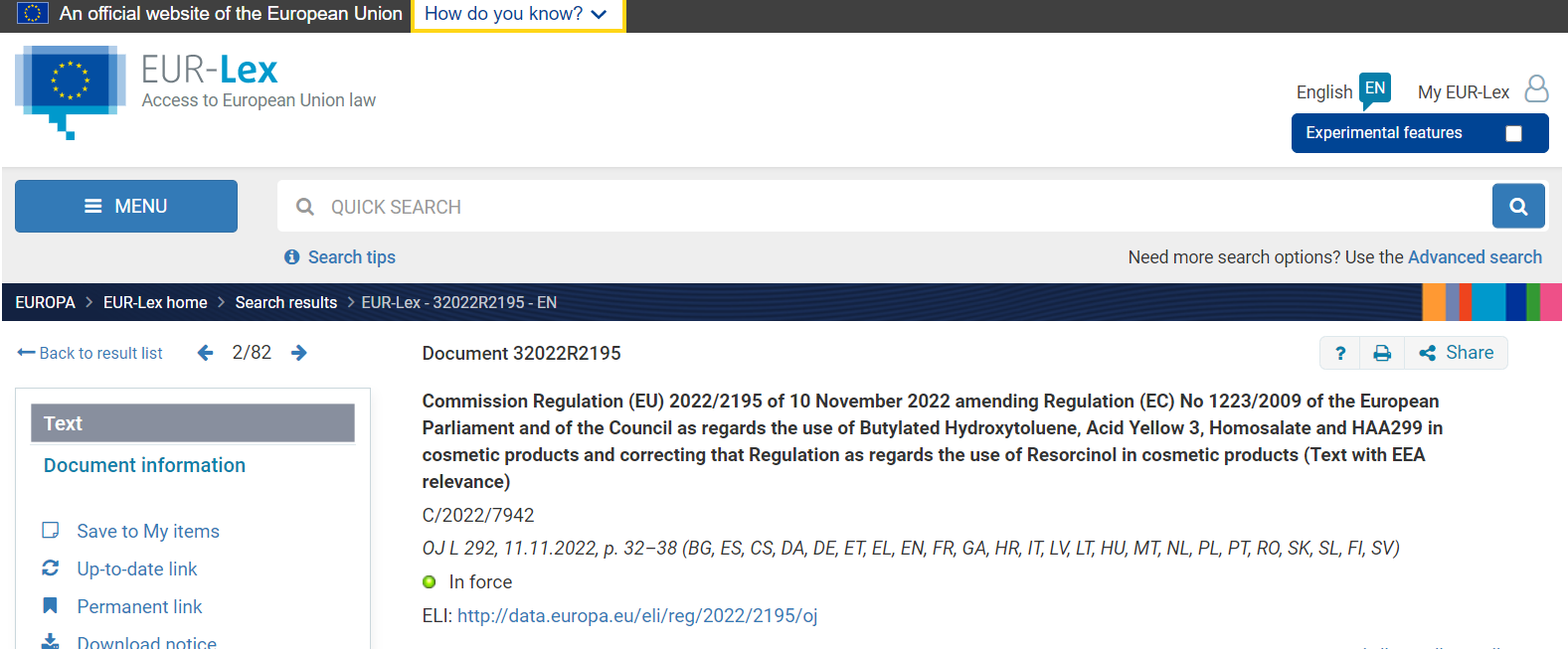On November 11, 2022, the European Commission issued Regulation (EU) 2022/2195, amending the requirements of European Cosmetics Regulation (EC) No 1223/2009 on the use of Humosalate and Resorcinol, and adding the restrictions on the use of Butylated Hydroxytoluene, Acid Yellow 3 and HAA299 (nano and non nano forms). This revision mainly refers to the scientific opinions issued by the Scientific Committee on Consumer Safety (SCCS) in 2021. This Regulation shall enter into force on the twentieth day following that of its publication in the Official Journal of the European Union.

Cosmetics Regulation (EC) No 1223/2009 is amended as follows:
As a synthetic antioxidant, Butylated Hydroxytoluene (CAS No 128-37-0) is not currently regulated under Regulation (EC) No 1223/2009. The SCCS concluded in its opinion on December 2, 2021, that Butylated Hydroxytoluene is safe as an ingredient up to a maximum concentration of 0.001% in mouthwash, 0.1% in toothpaste and 0.8% in other leave-on and rinse-off products when those product categories are used individually or together.
The substance Acid Yellow 3 (CAS No 8004-92-0) is currently listed under entry 82 of Annex IV to Regulation (EC) No 1223/2009 and is therefore allowed for use as a colorant in cosmetic products without any maximum concentration. However, the SCCS concluded in its opinion on July 23, 2021, that Acid Yellow 3 is safe when used in such products at on-head concentrations of up to 0.5%.
Homosalate (CAS No 118-56-9) is listed under entry three of Annex VI to Regulation (EC) No 1223/2009 and is therefore allowed for use as a UV filter in cosmetic products with a maximum concentration of 10% in ready-for-use preparation. In light of the SCCS scientific advice issued on December 2, 2021, it can be concluded that there is a potential risk to human health arising from the use of Homosalate as a UV filter in cosmetic products in the concentration currently allowed. Therefore, the use of Homosalate should be restricted to face products (non-spray and pump spray products) only up to a maximum concentration of 7.34%.
HAA299 (CAS No 919803-06-8), is a cosmetic ingredient with the reported functions of a UV filter. HAA299 is currently not regulated under Regulation (EC) No 1223/2009. The SCCS finally concluded that it had not been provided with any data that would merit a revision of its previous opinion and that HAA299 therefore can be considered safe both in its nano and non-nano form when used as a UV filter in cosmetic products up to a maximum concentration of 10%. The SCCS also considers that the combined maximum concentration of nano and non-nano forms of HAA299 should not exceed 10% in a cosmetic product.
Resorcinol (CAS No 108-46-3) is currently listed under entry 22 of Annex III to Regulation (EC) No 1223/2009 as allowed for use in oxidative hair dye products, products intended for coloring eyelashes and hair lotions, and shampoos with certain restrictions. According to the definition of the term “hair product” in Regulation (EC) No 1223/2009, which became applicable on July 11, 2013, a hair product means a cosmetic product that is intended to be applied on the hair of the head or face, except for eyelashes. Therefore, in Annex III to Regulation (EC) No 1223/2009, in the row for entry 22, column i, point (a), the last sentence is replaced by the following: "Do not use to dye eyelashes.".
If you need any assistance or have any questions, please get in touch with us via service@cirs-group.com.
Further Information

